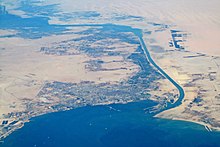
Back Suezkanaal Afrikaans Sueskanal ALS ስዌዝ ቦይ Amharic Canal de Suez AN قناة السويس Arabic قناة السويس ARZ ছুৱেজ খাল Assamese Canal de Suez AST स्वेज नहर AWA Süveyş kanalı Azerbaijani
| Suez Canal | |
|---|---|
 The Suez Canal from space, showing the Great Bitter Lake at the centre (after the 2015 expansion) | |
| Coordinates | 30°42′18″N 32°20′39″E / 30.70500°N 32.34417°E |
| Specifications | |
| Length | 193.3 km (120.1 miles) |
| Maximum boat beam | 77.5 m (254 ft 3 in) |
| Maximum boat draft | 20.1 m (66 ft) |
| Locks | None |
| Navigation authority | Suez Canal Authority |
| History | |
| Construction began | 25 April 1859 |
| Date completed | 17 November 1869 |
| Geography | |
| Start point | Port Said |
| End point | Suez Port |
The Suez Canal (Arabic: قَنَاةُ ٱلسُّوَيْسِ, Qanāt as-Suwais) is an artificial sea-level waterway in Egypt, connecting the Mediterranean Sea to the Red Sea through the Isthmus of Suez and dividing Africa and Asia (and by extension, the Sinai Peninsula from the rest of Egypt). The 193.30-kilometre-long (120.11 mi) canal is a key trade route between Europe and Asia.
In 1858, French diplomat Ferdinand de Lesseps formed the Compagnie de Suez for the express purpose of building the canal. Construction of the canal lasted from 1859 to 1869. The canal officially opened on 17 November 1869. It offers vessels a direct route between the North Atlantic and northern Indian oceans via the Mediterranean Sea and the Red Sea, avoiding the South Atlantic and southern Indian oceans and reducing the journey distance from the Arabian Sea to London by approximately 8,900 kilometres (5,500 mi), to 10 days at 20 knots (37 km/h; 23 mph) or 8 days at 24 knots (44 km/h; 28 mph).[1] The canal extends from the northern terminus of Port Said to the southern terminus of Port Tewfik at the city of Suez. In 2021, more than 20,600 vessels traversed the canal (an average of 56 per day).[2]
The original canal featured a single-lane waterway with passing locations in the Ballah Bypass and the Great Bitter Lake.[3] It contained, according to Alois Negrelli's plans, no locks, with seawater flowing freely through it. In general, the water in the canal north of the Bitter Lakes flows north in winter and south in summer. South of the lakes, the current changes with the tide at Suez.[4]
The canal was the property of the Egyptian government, but European shareholders, mostly British and French, owned the concessionary company which operated it until July 1956, when President Gamal Abdel Nasser nationalised it—an event which led to the Suez Crisis of October–November 1956.[5] The canal is operated and maintained by the state-owned Suez Canal Authority[6] (SCA) of Egypt. Under the Convention of Constantinople, it may be used "in time of war as in time of peace, by every vessel of commerce or of war, without distinction of flag."[7] Nevertheless, the canal has played an important military strategic role as a naval short-cut and choke point. Navies with coastlines and bases on both the Mediterranean Sea and the Red Sea (Egypt and Israel) have a particular interest in the Suez Canal. After Egypt closed the Suez Canal at the beginning of the Six-Day War on 5 June 1967, the canal remained closed for eight years, reopening on 5 June 1975.[8]
The Egyptian government launched construction in 2014 to expand and widen the Ballah Bypass for 35 km (22 mi) to speed up the canal's transit time. The expansion intended to nearly double the capacity of the Suez Canal, from 49 to 97 ships per day.[9] At a cost of LE 59.4 billion (US$9 billion), this project was funded with interest-bearing investment certificates issued exclusively to Egyptian entities and individuals.
The Suez Canal Authority officially opened the new side channel in 2016. This side channel, at the northern side of the east extension of the Suez Canal, serves the East Terminal for berthing and unberthing vessels from the terminal. As the East Container Terminal is located on the Canal itself, before the construction of the new side channel it was not possible to berth or unberth vessels at the terminal while a convoy was running.[10]

- ^ "The Suez Canal – A vital shortcut for global commerce" (PDF). World Shipping Council. Archived (PDF) from the original on 22 April 2018. Retrieved 15 March 2019.
- ^ "Number of ships passing through the Suez Canal from 1976 to 2021". Statista. 31 March 2022.
- ^ "Suez Canal Authority". Archived from the original on 13 June 2014. Retrieved 2 May 2010.
- ^ Elaine Morgan; Stephen Davies (1995). The Red Sea Pilot. Imray Laurie Norie & Wilson. p. 266. ISBN 9780852885543.
- ^ "Suez Crisis". History.com. A&E Television Networks. 9 November 2009. Archived from the original on 30 March 2019. Retrieved 17 April 2019.
- ^ "SCA Overview". Suez Canal Authority. Archived from the original on 25 June 2019. Retrieved 25 July 2019.
- ^ Constantinople Convention of the Suez Canal of 2 March 1888 still in force and specifically maintained in Nasser's Nationalization Act.
- ^ Feyrer, James. "Distance, Trade, and Income – The 1967 to 1975 Closing of the Suez Canal as a Natural Experiment" (PDF). National Bureau of Economic Research. Archived (PDF) from the original on 11 February 2021. Retrieved 27 March 2021.
- ^ "New Suez Canal project proposed by Egypt to boost trade". caironews.net. Archived from the original on 29 November 2014. Retrieved 7 August 2014.
- ^ "Egypt opens East Port Said side channel for navigation". Xinhua. Archived from the original on 25 February 2016. Retrieved 12 March 2016.
© MMXXIII Rich X Search. We shall prevail. All rights reserved. Rich X Search